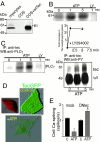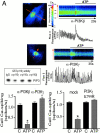A specific role of phosphatidylinositol 3-kinase gamma. A regulation of autonomic Ca(2)+ oscillations in cardiac cells
- PMID: 11266463
- PMCID: PMC2195768
- DOI: 10.1083/jcb.152.4.717
A specific role of phosphatidylinositol 3-kinase gamma. A regulation of autonomic Ca(2)+ oscillations in cardiac cells
Abstract
Purinergic stimulation of cardiomyocytes turns on a Src family tyrosine kinase-dependent pathway that stimulates PLCgamma and generates IP(3), a breakdown product of phosphatidylinositol 4,5-bisphosphate (PIP2). This signaling pathway closely regulates cardiac cell autonomic activity (i.e., spontaneous cell Ca(2+) spiking). PIP2 is phosphorylated on 3' by phosphoinositide 3-kinases (PI3Ks) that belong to a broad family of kinase isoforms. The product of PI3K, phosphatidylinositol 3,4,5-trisphosphate, regulates activity of PLCgamma. PI3Ks have emerged as crucial regulators of many cell functions including cell division, cell migration, cell secretion, and, via PLCgamma, Ca(2+) homeostasis. However, although PI3Kalpha and -beta have been shown to mediate specific cell functions in nonhematopoietic cells, such a role has not been found yet for PI3Kgamma. We report that neonatal rat cardiac cells in culture express PI3Kalpha, -beta, and -gamma. The purinergic agonist predominantly activates PI3Kgamma. Both wortmannin and LY294002 prevent tyrosine phosphorylation, and membrane translocation of PLCgamma as well as IP(3) generation in ATP-stimulated cells. Furthermore, an anti-PI3Kgamma, but not an anti-PI3Kbeta, injected in the cells prevents the effect of ATP on cell Ca(2+) spiking. A dominant negative mutant of PI3Kgamma transfected in the cells also exerts the same action. The effect of ATP was observed on spontaneous Ca(2+) spiking of wild-type but not of PI3Kgamma(2/2) embryonic stem cell-derived cardiomyocytes. ATP activates the Btk tyrosine kinase, Tec, and induces its association with PLCgamma. A dominant negative mutant of Tec blocks the purinergic effect on cell Ca(2+) spiking. Tec is translocated to the T-tubes upon ATP stimulation of cardiac cells. Both an anti-PI3Kgamma antibody and a dominant negative mutant of PI3Kgamma injected or transfected into cells prevent the latter event. We conclude that PI3Kgamma activation is a crucial step in the purinergic regulation of cardiac cell spontaneous Ca(2+) spiking. Our data further suggest that Tec works in concert with a Src family kinase and PI3Kgamma to fully activate PLCgamma in ATP-stimulated cardiac cells. This cluster of kinases provides the cardiomyocyte with a tight regulation of IP(3) generation and thus cardiac autonomic activity.
Figures








References
-
- Benistant C., Chapuis H., Roche S. A specific function for phosphatidylinositol 3-kinase α (p85-p110α) in cell survival and for phosphatidylinositol 3-kinase β (p85-p110β) in de novo DNA synthesis of human colon carcinoma cells. Oncogene. 2000;19:5083–5093. - PubMed
-
- Berridge M.J. Inositol trisphosphate and calcium signaling. Ann. NY Acad. Sci. 1995;766:31–43. - PubMed
-
- Clapham D.E. Calcium signaling. Cell. 1995;80:259–268. - PubMed
-
- Downing G.J., Kim S., Nakanishi S., Catt K.J., Balla T. Characterization of a soluble adrenal phosphatidylinositol 4-kinase reveals wortmannin sensitivity of type III phosphatidylinositol kinases. Biochemistry. 1996;35:3587–3594. - PubMed
Publication types
MeSH terms
Substances
LinkOut - more resources
Full Text Sources
Molecular Biology Databases
Miscellaneous

